Channel 6 Video — original link
Play video
Play video

Refresher Training Boards and Commissions 2021 Texas Open Meetings Act Meetings of governmental bodies must be open to public • Agendas posted at least 72 hours prior to meeting & include: date, time, place & subject of each item • Quorum present to convene • Meetings required to be audio recorded (unless ATXN records) • Recordings are posted online & kept indefinitely All boards must comply with the Texas Open Meetings Act (TOMA) Agendas Properly publishing agendas is a critical part of the City’s duty to provide transparency to the public Agendas must be written so any reasonable person may understand what is intended to be discussed • Include all issues to be considered and any action or vote scheduled • Example: “Possible discussion and action of…” Agendas • Agendas are compiled by staff liaison with input from executive liaison, members, and staff • Chair approves final agenda, but does not have discretionary authority to remove • items may be postponed or accelerated due to agenda length, council deadlines, allotted time, etc. Members may include an item on an agenda when: Sponsorship is received from 2 or more members (5 days before meeting) OR Requested during a meeting under New Business/Future Items from 2 or more members Agendas Agendas are required to allow public comment • Citizen Communication • Speaker may address any topic that is not an agenda item • Number of people may be limited • Speaker sign-up • Must be allowed for any agenda item except item posted as a briefing • No limit on number of people Board Bylaws Each board has, at least, a standard set of bylaws which include: • the board’s mission; • procedures for selecting the officers; • outline duties of each officer; • requirements for establishing committees & working groups; • guidelines for posting meetings; • and using Robert’s Rules of Order Current bylaws are posted on each board’s webpage Bylaw Amendment Process 1. Bylaw amendments approved by the board 2. Board submits proposed changes to the City Clerk’s Office (OCC) 3. OCC submits proposed changes to Audit & Finance Council Committee (AFC) • Board Chairs are invited to speak to the changes • AFC makes recommendation to full Council 4. Proposed changes are then presented to full Council for final approval Committees and Working Groups Committees Working Groups Permanent bodies added to bylaw Temporary bodies Meet quarterly Present annual report …
Play video
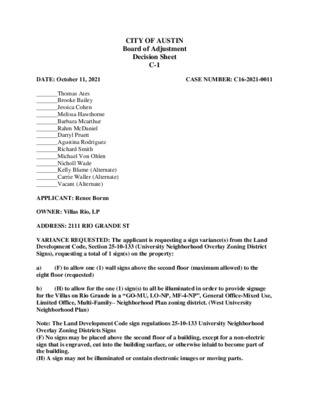
CITY OF AUSTIN Board of Adjustment Decision Sheet C-1 DATE: October 11, 2021 CASE NUMBER: C16-2021-0011 _______Thomas Ates _______Brooke Bailey _______Jessica Cohen _______Melissa Hawthorne _______Barbara Mcarthur _______Rahm McDaniel _______Darryl Pruett _______Agustina Rodriguez _______Richard Smith _______Michael Von Ohlen _______Nicholl Wade _______Kelly Blume (Alternate) _______Carrie Waller (Alternate) _______Vacant (Alternate) APPLICANT: Renee Bornn OWNER: Villas Rio, LP ADDRESS: 2111 RIO GRANDE ST VARIANCE REQUESTED: The applicant is requesting a sign variance(s) from the Land Development Code, Section 25-10-133 (University Neighborhood Overlay Zoning District Signs), requesting a total of 1 sign(s) on the property: (F) to allow one (1) wall signs above the second floor (maximum allowed) to the a) eight floor (requested) (H) to allow for the one (1) sign(s) to all be illuminated in order to provide signage b) for the Villas on Rio Grande in a “GO-MU, LO-NP, MF-4-NP”, General Office-Mixed Use, Limited Office, Multi-Family– Neighborhood Plan zoning district. (West University Neighborhood Plan) Note: The Land Development Code sign regulations 25-10-133 University Neighborhood Overlay Zoning Districts Signs (F) No signs may be placed above the second floor of a building, except for a non-electric sign that is engraved, cut into the building surface, or otherwise inlaid to become part of the building. (H) A sign may not be illuminated or contain electronic images or moving parts. BOARD’S DECISION: Oct 11, 2021 BOA MEETING POSTPONED TO NOVEMBER 8, 2021 BY BOARD MEMBERS (AS REQUESTED BY APPLICANT) FINDING: 1. The variance is necessary because strict enforcement of the Article prohibits and reasonable opportunity to provide adequate signs on the site, considering the unique features of a site such as its dimensions, landscape, or topography, because: OR, 2. The granting of this variance will not have a substantially adverse impact upon neighboring properties, because: OR, 3. The granting of this variance will not substantially conflict with the stated purposes of this sign ordinance, because: AND, 4. Granting a variance would not provide the applicant with a special privilege not enjoyed by others similarly situated or potentially similarly situated, because: ______________________________ Elaine Ramirez Executive Liaison Jessica Cohen Madam Chair ____________________________ for
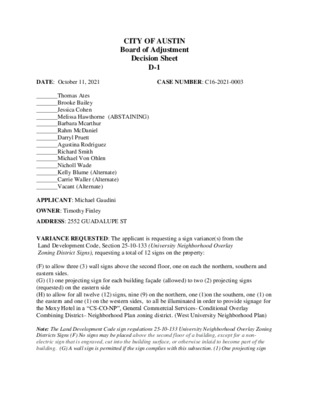
CITY OF AUSTIN Board of Adjustment Decision Sheet D-1 DATE: October 11, 2021 CASE NUMBER: C16-2021-0003 _______Thomas Ates _______Brooke Bailey _______Jessica Cohen _______Melissa Hawthorne (ABSTAINING) _______Barbara Mcarthur _______Rahm McDaniel _______Darryl Pruett _______Agustina Rodriguez _______Richard Smith _______Michael Von Ohlen _______Nicholl Wade _______Kelly Blume (Alternate) _______Carrie Waller (Alternate) _______Vacant (Alternate) APPLICANT: Michael Gaudini OWNER: Timothy Finley ADDRESS: 2552 GUADALUPE ST VARIANCE REQUESTED: The applicant is requesting a sign variance(s) from the Land Development Code, Section 25-10-133 (University Neighborhood Overlay Zoning District Signs), requesting a total of 12 signs on the property: (F) to allow three (3) wall signs above the second floor, one on each the northern, southern and eastern sides. (G) (1) one projecting sign for each building façade (allowed) to two (2) projecting signs (requested) on the eastern side (H) to allow for all twelve (12) signs, nine (9) on the northern, one (1)on the southern, one (1) on the eastern and one (1) on the western sides, to all be illuminated in order to provide signage for the Moxy Hotel in a “CS-CO-NP”, General Commercial Services- Conditional Overlay Combining District– Neighborhood Plan zoning district. (West University Neighborhood Plan) Note: The Land Development Code sign regulations 25-10-133 University Neighborhood Overlay Zoning Districts Signs (F) No signs may be placed above the second floor of a building, except for a non- electric sign that is engraved, cut into the building surface, or otherwise inlaid to become part of the building. (G) A wall sign is permitted if the sign complies with this subsection. (1) One projecting sign for each building façade is permitted (H) A sign may not be illuminated or contain electronic images or moving parts. BOARD’S DECISION: Jan 11, 2021 POSTPONED TO FEBRUARY 8, 2021 (Board member Melissa Hawthorne abstaining); Feb 8, 2021 POSTPONED TO MARCH 8, 2021; March 8, 2020 The public hearing was closed by Chair Don Leighton-Burwell, Board Member Veronica Rivera motions to Postpone to April 12, 2021; Board Member Rahm McDaniel seconds on a 9-0 vote (Board member Melissa Hawthorne abstained); POSTPONED TO APRIL 12, 2021. (RENOTICE) VARIANCE REQUESTED: RENOTICE The applicant is requesting a sign variance(s) from the Land Development Code, Section 25-10-133 (University Neighborhood Overlay Zoning District Signs), requesting a total of 12 signs on the property: a) b) c) (F) to allow three (3) wall signs above the second floor, one on each the northern, southern and eastern sides. (G) (1) one …
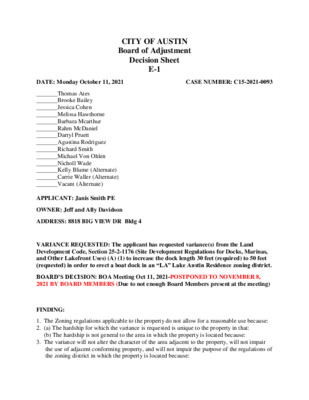
CITY OF AUSTIN Board of Adjustment Decision Sheet E-1 DATE: Monday October 11, 2021 CASE NUMBER: C15-2021-0093 _______Thomas Ates _______Brooke Bailey _______Jessica Cohen _______Melissa Hawthorne _______Barbara Mcarthur _______Rahm McDaniel _______Darryl Pruett _______Agustina Rodriguez _______Richard Smith _______Michael Von Ohlen _______Nicholl Wade _______Kelly Blume (Alternate) _______Carrie Waller (Alternate) _______Vacant (Alternate) APPLICANT: Janis Smith PE OWNER: Jeff and Ally Davidson ADDRESS: 8818 BIG VIEW DR Bldg 4 VARIANCE REQUESTED: The applicant has requested variance(s) from the Land Development Code, Section 25-2-1176 (Site Development Regulations for Docks, Marinas, and Other Lakefront Uses) (A) (1) to increase the dock length 30 feet (required) to 50 feet (requested) in order to erect a boat dock in an “LA” Lake Austin Residence zoning district. BOARD’S DECISION: BOA Meeting Oct 11, 2021-POSTPONED TO NOVEMBER 8, 2021 BY BOARD MEMBERS (Due to not enough Board Members present at the meeting) FINDING: 1. The Zoning regulations applicable to the property do not allow for a reasonable use because: 2. (a) The hardship for which the variance is requested is unique to the property in that: (b) The hardship is not general to the area in which the property is located because: 3. The variance will not alter the character of the area adjacent to the property, will not impair the use of adjacent conforming property, and will not impair the purpose of the regulations of the zoning district in which the property is located because: ______________________________ Elaine Ramirez Executive Liaison ____________________________ Jessica Cohen Madam Chair for
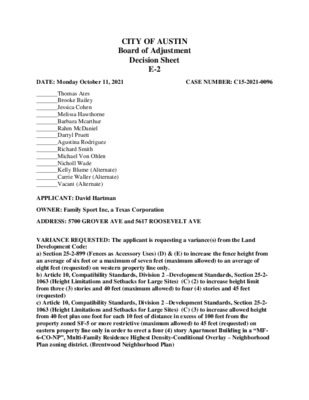
CITY OF AUSTIN Board of Adjustment Decision Sheet E-2 DATE: Monday October 11, 2021 CASE NUMBER: C15-2021-0096 _______Thomas Ates _______Brooke Bailey _______Jessica Cohen _______Melissa Hawthorne _______Barbara Mcarthur _______Rahm McDaniel _______Darryl Pruett _______Agustina Rodriguez _______Richard Smith _______Michael Von Ohlen _______Nicholl Wade _______Kelly Blume (Alternate) _______Carrie Waller (Alternate) _______Vacant (Alternate) APPLICANT: David Hartman OWNER: Family Sport Inc, a Texas Corporation ADDRESS: 5700 GROVER AVE and 5617 ROOSEVELT AVE VARIANCE REQUESTED: The applicant is requesting a variance(s) from the Land Development Code: a) Section 25-2-899 (Fences as Accessory Uses) (D) & (E) to increase the fence height from an average of six feet or a maximum of seven feet (maximum allowed) to an average of eight feet (requested) on western property line only. b) Article 10, Compatibility Standards, Division 2 –Development Standards, Section 25-2- 1063 (Height Limitations and Setbacks for Large Sites) (C) (2) to increase height limit from three (3) stories and 40 feet (maximum allowed) to four (4) stories and 45 feet (requested) c) Article 10, Compatibility Standards, Division 2 –Development Standards, Section 25-2- 1063 (Height Limitations and Setbacks for Large Sites) (C) (3) to increase allowed height from 40 feet plus one foot for each 10 feet of distance in excess of 100 feet from the property zoned SF-5 or more restrictive (maximum allowed) to 45 feet (requested) on eastern property line only in order to erect a four (4) story Apartment Building in a “MF- 6-CO-NP”, Multi-Family Residence Highest Density-Conditional Overlay – Neighborhood Plan zoning district. (Brentwood Neighborhood Plan) Note: The Land Development Code Section 25-2-899 (Fences as Accessory Uses) (D) Except as otherwise provided in this section, a solid fence constructed along a property line may not exceed an average height of six feet or a maximum height of seven feet. (E) A solid fence along a property line may be constructed to a maximum height of eight feet if each owner of property that adjoins a section of the fence that exceeds a height of six feet files a written consent to the construction of the fence with the building official, and… Section 25-2-1063 Height Limitations and Setbacks for Large Sites (C) (2) three stories and 40 feet, if the structure is more than 50 feet and not more than 100 feet from property. (C) (3) for a structure more than 100 feet but not more than 300 feet from property zoned SF-5 or more restrictive, 40 …
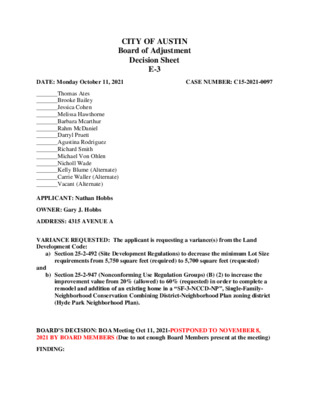
CITY OF AUSTIN Board of Adjustment Decision Sheet E-3 DATE: Monday October 11, 2021 CASE NUMBER: C15-2021-0097 _______Thomas Ates _______Brooke Bailey _______Jessica Cohen _______Melissa Hawthorne _______Barbara Mcarthur _______Rahm McDaniel _______Darryl Pruett _______Agustina Rodriguez _______Richard Smith _______Michael Von Ohlen _______Nicholl Wade _______Kelly Blume (Alternate) _______Carrie Waller (Alternate) _______Vacant (Alternate) APPLICANT: Nathan Hobbs OWNER: Gary J. Hobbs ADDRESS: 4315 AVENUE A VARIANCE REQUESTED: The applicant is requesting a variance(s) from the Land Development Code: a) Section 25-2-492 (Site Development Regulations) to decrease the minimum Lot Size requirements from 5,750 square feet (required) to 5,700 square feet (requested) and b) Section 25-2-947 (Nonconforming Use Regulation Groups) (B) (2) to increase the improvement value from 20% (allowed) to 60% (requested) in order to complete a remodel and addition of an existing home in a “SF-3-NCCD-NP”, Single-Family- Neighborhood Conservation Combining District-Neighborhood Plan zoning district (Hyde Park Neighborhood Plan). BOARD’S DECISION: BOA Meeting Oct 11, 2021-POSTPONED TO NOVEMBER 8, 2021 BY BOARD MEMBERS (Due to not enough Board Members present at the meeting) FINDING: 1. The Zoning regulations applicable to the property do not allow for a reasonable use because: 2. (a) The hardship for which the variance is requested is unique to the property in that: (b) The hardship is not general to the area in which the property is located because: 3. The variance will not alter the character of the area adjacent to the property, will not impair the use of adjacent conforming property, and will not impair the purpose of the regulations of the zoning district in which the property is located because: ______________________________ Elaine Ramirez Executive Liaison ____________________________ Jessica Cohen Madam Chair for
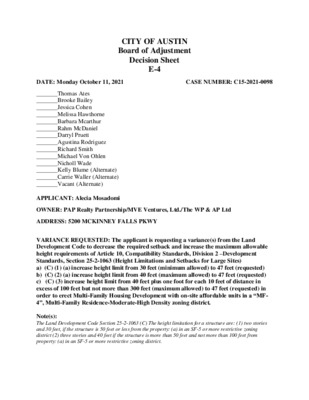
CITY OF AUSTIN Board of Adjustment Decision Sheet E-4 DATE: Monday October 11, 2021 CASE NUMBER: C15-2021-0098 _______Thomas Ates _______Brooke Bailey _______Jessica Cohen _______Melissa Hawthorne _______Barbara Mcarthur _______Rahm McDaniel _______Darryl Pruett _______Agustina Rodriguez _______Richard Smith _______Michael Von Ohlen _______Nicholl Wade _______Kelly Blume (Alternate) _______Carrie Waller (Alternate) _______Vacant (Alternate) APPLICANT: Alecia Mosadomi OWNER: PAP Realty Partnership/MVE Ventures, Ltd./The WP & AP Ltd ADDRESS: 5200 MCKINNEY FALLS PKWY VARIANCE REQUESTED: The applicant is requesting a variance(s) from the Land Development Code to decrease the required setback and increase the maximum allowable height requirements of Article 10, Compatibility Standards, Division 2 –Development Standards, Section 25-2-1063 (Height Limitations and Setbacks for Large Sites) a) (C) (1) (a) increase height limit from 30 feet (minimum allowed) to 47 feet (requested) b) (C) (2) (a) increase height limit from 40 feet (maximum allowed) to 47 feet (requested) c) (C) (3) increase height limit from 40 feet plus one foot for each 10 feet of distance in excess of 100 feet but not more than 300 feet (maximum allowed) to 47 feet (requested) in order to erect Multi-Family Housing Development with on-site affordable units in a “MF- 4”, Multi-Family Residence-Moderate-High Density zoning district. Note(s): The Land Development Code Section 25-2-1063 (C) The height limitation for a structure are: (1) two stories and 30 feet, if the structure is 50 feet or less from the property: (a) in an SF-5 or more restrictive zoning district (2) three stories and 40 feet if the structure is more than 50 feet and not more than 100 feet from property: (a) in an SF-5 or more restrictive zoning district. BOARD’S DECISION: BOA Meeting Oct 11, 2021-POSTPONED TO NOVEMBER 8, 2021 BY BOARD MEMBERS (Due to not enough Board Members present at the meeting) FINDING: 1. The Zoning regulations applicable to the property do not allow for a reasonable use because: 2. (a) The hardship for which the variance is requested is unique to the property in that: (b) The hardship is not general to the area in which the property is located because: 3. The variance will not alter the character of the area adjacent to the property, will not impair the use of adjacent conforming property, and will not impair the purpose of the regulations of the zoning district in which the property is located because: ______________________________ Elaine Ramirez Executive Liaison ____________________________ Jessica Cohen Madam Chair for
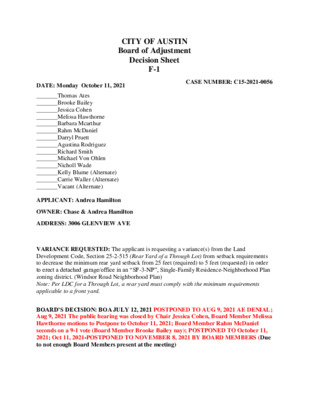
CITY OF AUSTIN Board of Adjustment Decision Sheet F-1 CASE NUMBER: C15-2021-0056 DATE: Monday October 11, 2021 _______Thomas Ates _______Brooke Bailey _______Jessica Cohen _______Melissa Hawthorne _______Barbara Mcarthur _______Rahm McDaniel _______Darryl Pruett _______Agustina Rodriguez _______Richard Smith _______Michael Von Ohlen _______Nicholl Wade _______Kelly Blume (Alternate) _______Carrie Waller (Alternate) _______Vacant (Alternate) APPLICANT: Andrea Hamilton OWNER: Chase & Andrea Hamilton ADDRESS: 3006 GLENVIEW AVE VARIANCE REQUESTED: The applicant is requesting a variance(s) from the Land Development Code, Section 25-2-515 (Rear Yard of a Through Lot) from setback requirements to decrease the minimum rear yard setback from 25 feet (required) to 5 feet (requested) in order to erect a detached garage/office in an “SF-3-NP”, Single-Family Residence-Neighborhood Plan zoning district. (Windsor Road Neighborhood Plan) Note: Per LDC for a Through Lot, a rear yard must comply with the minimum requirements applicable to a front yard. BOARD’S DECISION: BOA JULY 12, 2021 POSTPONED TO AUG 9, 2021 AE DENIAL; Aug 9, 2021 The public hearing was closed by Chair Jessica Cohen, Board Member Melissa Hawthorne motions to Postpone to October 11, 2021; Board Member Rahm McDaniel seconds on a 9-1 vote (Board Member Brooke Bailey nay); POSTPONED TO October 11, 2021; Oct 11, 2021-POSTPONED TO NOVEMBER 8, 2021 BY BOARD MEMBERS (Due to not enough Board Members present at the meeting) FINDING: 1. The Zoning regulations applicable to the property do not allow for a reasonable use because: 2. (a) The hardship for which the variance is requested is unique to the property in that: (b) The hardship is not general to the area in which the property is located because: 3. The variance will not alter the character of the area adjacent to the property, will not impair the use of adjacent conforming property, and will not impair the purpose of the regulations of the zoning district in which the property is located because: ______________________________ Elaine Ramirez Executive Liaison ____________________________ Jessica Cohen Madam Chair for
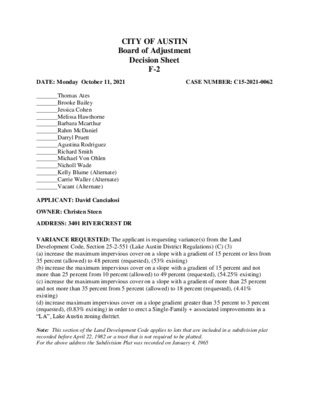
CITY OF AUSTIN Board of Adjustment Decision Sheet F-2 DATE: Monday October 11, 2021 CASE NUMBER: C15-2021-0062 _______Thomas Ates _______Brooke Bailey _______Jessica Cohen _______Melissa Hawthorne _______Barbara Mcarthur _______Rahm McDaniel _______Darryl Pruett _______Agustina Rodriguez _______Richard Smith _______Michael Von Ohlen _______Nicholl Wade _______Kelly Blume (Alternate) _______Carrie Waller (Alternate) _______Vacant (Alternate) APPLICANT: David Cancialosi OWNER: Christen Steen ADDRESS: 3401 RIVERCREST DR VARIANCE REQUESTED: The applicant is requesting variance(s) from the Land Development Code, Section 25-2-551 (Lake Austin District Regulations) (C) (3) (a) increase the maximum impervious cover on a slope with a gradient of 15 percent or less from 35 percent (allowed) to 48 percent (requested), (53% existing) (b) increase the maximum impervious cover on a slope with a gradient of 15 percent and not more than 25 percent from 10 percent (allowed) to 49 percent (requested), (54.25% existing) (c) increase the maximum impervious cover on a slope with a gradient of more than 25 percent and not more than 35 percent from 5 percent (allowed) to 18 percent (requested), (4.41% existing) (d) increase maximum impervious cover on a slope gradient greater than 35 percent to 3 percent (requested), (0.83% existing) in order to erect a Single-Family + associated improvements in a “LA”, Lake Austin zoning district. Note: This section of the Land Development Code applies to lots that are included in a subdivision plat recorded before April 22, 1982 or a tract that is not required to be platted. For the above address the Subdivision Plat was recorded on January 4, 1965 The overall change in IC is from 21.51% to a proposed 20.89% IC, or 8,084 SF IC to 7,883 SF IC, when calculated on a gross lot area basis. BOARD’S DECISION: BOA JULY 12, 2021 POSTPONED TO AUGUST 9, 2021; Aug 9, 2021 The public hearing was closed by Chair Jessica Cohen, Board Member Melissa Hawthorne motions to Postpone to October 11, 2021; Board Member Brooke Bailey seconds on a 10-0 vote; POSTPONED TO October 11, 2021; Oct 11, 2021-POSTPONED TO NOVEMBER 8, 2021 BY BOARD MEMBERS (Due to not enough Board Members present at the meeting) FINDING: 1. The Zoning regulations applicable to the property do not allow for a reasonable use because: 2. (a) The hardship for which the variance is requested is unique to the property in that: (b) The hardship is not general to the area in which the property is located because: 3. The variance …
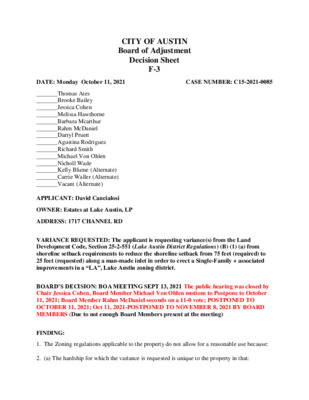
CITY OF AUSTIN Board of Adjustment Decision Sheet F-3 DATE: Monday October 11, 2021 CASE NUMBER: C15-2021-0085 _______Thomas Ates _______Brooke Bailey _______Jessica Cohen _______Melissa Hawthorne _______Barbara Mcarthur _______Rahm McDaniel _______Darryl Pruett _______Agustina Rodriguez _______Richard Smith _______Michael Von Ohlen _______Nicholl Wade _______Kelly Blume (Alternate) _______Carrie Waller (Alternate) _______Vacant (Alternate) APPLICANT: David Cancialosi OWNER: Estates at Lake Austin, LP ADDRESS: 1717 CHANNEL RD VARIANCE REQUESTED: The applicant is requesting variance(s) from the Land Development Code, Section 25-2-551 (Lake Austin District Regulations) (B) (1) (a) from shoreline setback requirements to reduce the shoreline setback from 75 feet (required) to 25 feet (requested) along a man-made inlet in order to erect a Single-Family + associated improvements in a “LA”, Lake Austin zoning district. BOARD’S DECISION: BOA MEETING SEPT 13, 2021 The public hearing was closed by Chair Jessica Cohen, Board Member Michael Von Ohlen motions to Postpone to October 11, 2021; Board Member Rahm McDaniel seconds on a 11-0 vote; POSTPONED TO OCTOBER 11, 2021; Oct 11, 2021-POSTPONED TO NOVEMBER 8, 2021 BY BOARD MEMBERS (Due to not enough Board Members present at the meeting) FINDING: 1. The Zoning regulations applicable to the property do not allow for a reasonable use because: 2. (a) The hardship for which the variance is requested is unique to the property in that: (b) The hardship is not general to the area in which the property is located because: 3. The variance will not alter the character of the area adjacent to the property, will not impair the use of adjacent conforming property, and will not impair the purpose of the regulations of the zoning district in which the property is located because: ______________________________ Elaine Ramirez Executive Liaison ____________________________ Jessica Cohen Madam Chair for
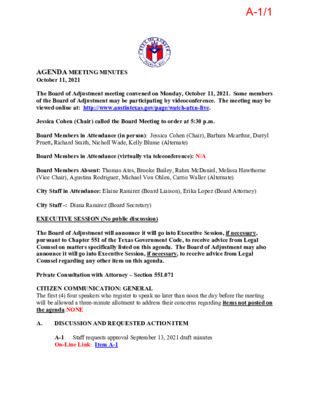
AGENDA MEETING MINUTES October 11, 2021 The Board of Adjustment meeting convened on Monday, October 11, 2021. Some members of the Board of Adjustment may be participating by videoconference. The meeting may be viewed online at: http://www.austintexas.gov/page/watch-atxn-live. Jessica Cohen (Chair) called the Board Meeting to order at 5:30 p.m. Board Members in Attendance (in person): Jessica Cohen (Chair), Barbara Mcarthur, Darryl Pruett, Richard Smith, Nicholl Wade, Kelly Blume (Alternate) Board Members in Attendance (virtually via teleconference): N/A Board Members Absent: Thomas Ates, Brooke Bailey, Rahm McDaniel, Melissa Hawthorne (Vice Chair), Agustina Rodriguez, Michael Von Ohlen, Carrie Waller (Alternate) City Staff in Attendance: Elaine Ramirez (Board Liaison), Erika Lopez (Board Attorney) City Staff -: Diana Ramirez (Board Secretary) EXECUTIVE SESSION (No public discussion) The Board of Adjustment will announce it will go into Executive Session, if necessary, pursuant to Chapter 551 of the Texas Government Code, to receive advice from Legal Counsel on matters specifically listed on this agenda. The Board of Adjustment may also announce it will go into Executive Session, if necessary, to receive advice from Legal Counsel regarding any other item on this agenda. Private Consultation with Attorney – Section 551.071 CITIZEN COMMUNICATION: GENERAL The first (4) four speakers who register to speak no later than noon the day before the meeting will be allowed a three-minute allotment to address their concerns regarding items not posted on the agenda.NONE A. DISCUSSION AND REQUESTED ACTION ITEM Staff requests approval September 13, 2021 draft minutes A-1 On-Line Link: Item A-1 A-1/1 Board Member Richard Smith motions to approve the minutes for September 13, 2021, Board member Barbara Mcarthur seconds on a 6-0 vote; APPROVED MINUTES FOR SEPTEMBER 13, 2021. B. DISCUSSION AND REQUESTED ACTION ITEM B-1 Staff and Applicant requests for postponement and withdraw of items posted on this Agenda Requesting postponements by applicant for Items C-1, F-1 and D-1 Board member Darryl Pruett motions to postpone Items C-1, F-1 to November 8, 2021 and D-1 to April 11, 2022, Board member Richard Smith seconds on a 6-0 vote; APPROVED POSTPONED ITEMS C-1, F-1 TO NOVEMBER 8, 2021 AND D-1 TO APRIL 11, 2022 AS REQESTED BY APPLCIANTS. Due to not enough Board Members present at the meeting Items E-1, E-2, E-3, E-4, F-2 and F-3 will be postponed to November 8, 2021. Madam Chair Jessica Cohen motions to Postpone Items E-1, E-2, E-3, E-4, F-2, and F-3 to November …
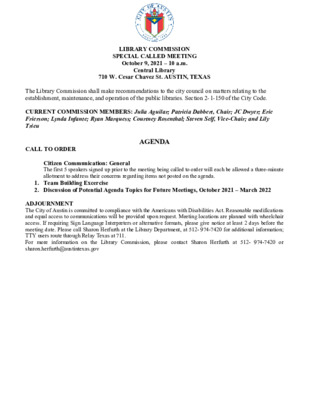
LIBRARY COMMISSION SPECIAL CALLED MEETING October 9, 2021 – 10 a.m. Central Library 710 W. Cesar Chavez St. AUSTIN, TEXAS The Library Commission shall make recommendations to the city council on matters relating to the establishment, maintenance, and operation of the public libraries. Section 2-1-150 of the City Code. CURRENT COMMISSION MEMBERS: Julia Aguilar; Patricia Dabbert, Chair; JC Dwyer; Eric Frierson; Lynda Infante; Ryan Marquess; Courtney Rosenthal; Steven Self, Vice-Chair; and Lily Trieu AGENDA CALL TO ORDER Citizen Communication: General The first 5 speakers signed up prior to the meeting being called to order will each be allowed a three-minute allotment to address their concerns regarding items not posted on the agenda. 1. Team Building Excercise 2. Discussion of Potential Agenda Topics for Future Meetings, October 2021 – March 2022 ADJOURNMENT The City of Austin is committed to compliance with the Americans with Disabilities Act. Reasonable modifications and equal access to communications will be provided upon request. Meeting locations are planned with wheelchair access. If requiring Sign Language Interpreters or alternative formats, please give notice at least 2 days before the meeting date. Please call Sharon Herfurth at the Library Department, at 512- 974-7420 for additional information; TTY users route through Relay Texas at 711. For more information on the Library Commission, please contact Sharon Herfurth at 512- 974-7420 or sharon.herfurth@austintexas.gov
Play audio
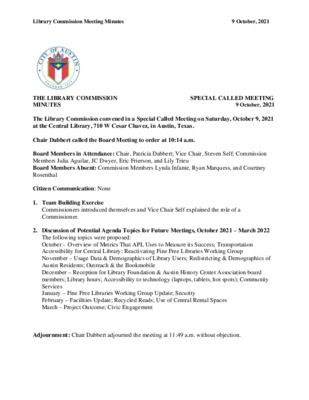
Library Commission Meeting Minutes 9 October, 2021 SPECIAL CALLED MEETING 9 October, 2021 THE LIBRARY COMMISSION MINUTES The Library Commission convened in a Special Called Meeting on Saturday, October 9, 2021 at the Central Library, 710 W Cesar Chavez, in Austin, Texas. Chair Dabbert called the Board Meeting to order at 10:14 a.m. Board Members in Attendance: Chair, Patricia Dabbert; Vice Chair, Steven Self; Commission Members Julia Aguilar, JC Dwyer, Eric Frierson, and Lily Trieu Board Members Absent: Commission Members Lynda Infante, Ryan Marquess, and Courtney Rosenthal Citizen Communication: None 1. Team Building Exercise Commissioners introduced themselves and Vice Chair Self explained the role of a Commissioner. 2. Discussion of Potential Agenda Topics for Future Meetings, October 2021 – March 2022 The following topics were proposed: October - Overview of Metrics That APL Uses to Measure its Success; Transportation Accessibility for Central Library; Reactivating Fine Free Libraries Working Group November – Usage Data & Demographics of Library Users; Redistricting & Demographics of Austin Residents; Outreach & the Bookmobile December – Reception for Library Foundation & Austin History Center Association board members; Library hours; Accessibility to technology (laptops, tablets, hot spots); Community Services January – Fine Free Libraries Working Group Update; Security February – Facilities Update; Recycled Reads; Use of Central Rental Spaces March – Project Outcome; Civic Engagement Adjournment: Chair Dabbert adjourned the meeting at 11:49 a.m. without objection.
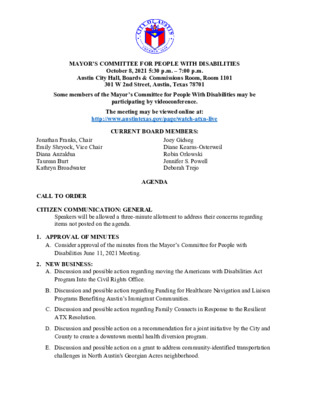
MAYOR’S COMMITTEE FOR PEOPLE WITH DISABILITIES October 8, 2021 5:30 p.m. – 7:00 p.m. Austin City Hall, Boards & Commissions Room, Room 1101 301 W 2nd Street, Austin, Texas 78701 Some members of the Mayor’s Committee for People With Disabilities may be participating by videoconference. The meeting may be viewed online at: http://www.austintexas.gov/page/watch-atxn-live CURRENT BOARD MEMBERS: Jonathan Franks, Chair Emily Shryock, Vice Chair Diana Anzaldua Taurean Burt Kathryn Broadwater CALL TO ORDER CITIZEN COMMUNICATION: GENERAL AGENDA Joey Gidseg Diane Kearns-Osterweil Robin Orlowski Jennifer S. Powell Deborah Trejo Speakers will be allowed a three-minute allotment to address their concerns regarding items not posted on the agenda. A. Consider approval of the minutes from the Mayor’s Committee for People with 1. APPROVAL OF MINUTES Disabilities June 11, 2021 Meeting. 2. NEW BUSINESS: Program Into the Civil Rights Office. A. Discussion and possible action regarding moving the Americans with Disabilities Act B. Discussion and possible action regarding Funding for Healthcare Navigation and Liaison Programs Benefiting Austin’s Immigrant Communities. C. Discussion and possible action regarding Family Connects in Response to the Resilient ATX Resolution. D. Discussion and possible action on a recommendation for a joint initiative by the City and County to create a downtown mental health diversion program. E. Discussion and possible action on a grant to address community-identified transportation challenges in North Austin's Georgian Acres neighborhood. F. Presentation by Brandi Bufford, Marketing Communications Consultant, Communication and Public Information Office, discussion and possible action regarding the City’s branding initiative to establish a consistent and clear City of Austin brand identity under SD 23. 3. OLD BUSINESS A. Discussion and possible action regarding American Sign Language (ASL) interpretation services and participation for people with disabilities during City Council meetings and press conferences, COVID-19 announcements, and other videos. 4. STAFF BRIEFINGS AND COMMISSIONER ANNOUNCEMENTS 5. FUTURE AGENDA ITEMS 6. ADJOURNMENT The City of Austin is committed to compliance with the American with Disabilities Act. Reasonable modifications and equal access to communications will be provided upon request. Meeting locations are planned with wheelchair access. If requiring Sign Language Interpreters or alternative formats, please give notice at least 2 days (48 hours) before the meeting date. Please call Jonathan Babiak, Office of Civil Rights, at (512) 974-3203 or jonathan.babiak@austintexas.gov, for additional information. TTY users’ route through Relay Texas at 711. For more information on the Mayor’s Committee for People with Disabilities, please contact Jonathan Babiak at (512) …
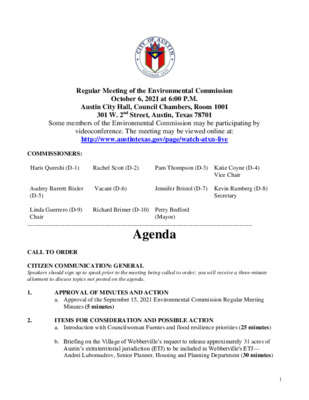
1. 2. Regular Meeting of the Environmental Commission October 6, 2021 at 6:00 P.M. Austin City Hall, Council Chambers, Room 1001 301 W. 2nd Street, Austin, Texas 78701 Some members of the Environmental Commission may be participating by videoconference. The meeting may be viewed online at: http://www.austintexas.gov/page/watch-atxn-live COMMISSIONERS: Haris Qureshi (D-1) Rachel Scott (D-2) Pam Thompson (D-3) Katie Coyne (D-4) Vice Chair Jennifer Bristol (D-7) Kevin Ramberg (D-8) Vacant (D-6) Audrey Barrett Bixler (D-5) Linda Guerrero (D-9) Chair _________________________________________________________________________________ Richard Brimer (D-10) Perry Bedford (Mayor) Secretary Agenda CALL TO ORDER CITIZEN COMMUNICATION: GENERAL Speakers should sign up to speak prior to the meeting being called to order; you will receive a three-minute allotment to discuss topics not posted on the agenda. APPROVAL OF MINUTES AND ACTION a. Approval of the September 15, 2021 Environmental Commission Regular Meeting Minutes (5 minutes) ITEMS FOR CONSIDERATION AND POSSIBLE ACTION a. Introduction with Councilwoman Fuentes and flood resilience priorities (25 minutes) b. Briefing on the Village of Webberville’s request to release approximately 31 acres of Austin’s extraterritorial jurisdiction (ETJ) to be included in Webberville's ETJ— Andrei Lubomudrov, Senior Planner, Housing and Planning Department (30 minutes) 1 3. PUBLIC HEARINGS a. Name: 305 South Congress Planned Unit Development (PUD), C814-89-0003.02 Applicant: Richard Suttle, Armbrust & Brown, PLLC Location: 305 South Congress Avenue, Austin, Texas 78704 Council District: District 9 Environmental Review Staff: Atha Phillips, Environmental Program Manager, Watershed Protection Department Zoning Case Manager: Kate Clark, Senior Planner, Housing and Planning Department Watershed: Colorado River Basin Request: To amend the current PUD Staff Recommendation: Current proposal is not recommended but staff recommend with the conditions attached in backup materials. (1 hour) 4. COMMITTEE REPORTS a. Urban Forestry Committee –Pam Thompson, Richard Brimer, and Linda Guerrero b. Report on the Joint Sustainability Committee – Katie Coyne c. Report on the Balcones Canyonlands Conservation Plan Citizen’s Advisory Committee – Kevin Ramberg d. Report on the Joint Committee of the Environmental Commission and Parks and Recreation Board –Linda Guerrero and Pam Thompson e. Report on the South Central Waterfront Advisory Board – Linda Guerrero FUTURE AGENDA ITEMS ADJOURNMENT The City of Austin is committed to compliance with the American with Disabilities Act. Reasonable modifications and equal access to communications will be provided upon request. Meeting locations are planned with wheelchair access. If requiring Sign Language Interpreters or alternative formats, please give notice at least 2 days before the meeting …
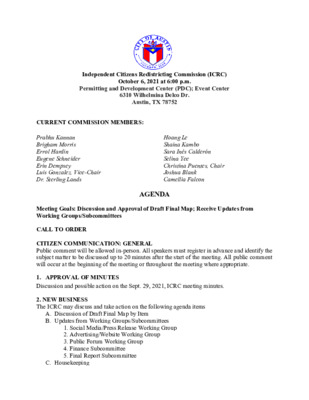
Independent Citizens Redistricting Commission (ICRC) October 6, 2021 at 6:00 p.m. Permitting and Development Center (PDC); Event Center 6310 Wilhelmina Delco Dr. Austin, TX 78752 CURRENT COMMISSION MEMBERS: Prabhu Kannan Brigham Morris Errol Hardin Eugene Schneider Erin Dempsey Luis Gonzalez, Vice-Chair Dr. Sterling Lands Hoang Le Shaina Kambo Sara Inés Calderón Selina Yee Christina Puentes, Chair Joshua Blank Camellia Falcon AGENDA Meeting Goals: Discussion and Approval of Draft Final Map; Receive Updates from Working Groups/Subcommittees CALL TO ORDER CITIZEN COMMUNICATION: GENERAL Public comment will be allowed in-person. All speakers must register in advance and identify the subject matter to be discussed up to 20 minutes after the start of the meeting. All public comment will occur at the beginning of the meeting or throughout the meeting where appropriate. 1. APPROVAL OF MINUTES Discussion and possible action on the Sept. 29, 2021, ICRC meeting minutes. 2. NEW BUSINESS The ICRC may discuss and take action on the following agenda items A. Discussion of Draft Final Map by Item B. Updates from Working Groups/Subcommittees 1. Social Media/Press Release Working Group 2. Advertising/Website Working Group 3. Public Forum Working Group 4. Finance Subcommittee 5. Final Report Subcommittee C. Housekeeping FUTURE AGENDA ITEMS ADJOURNMENT The City of Austin is committed to compliance with the American with Disabilities Act. Reasonable modifications and equal access to communications will be provided upon request. Meeting locations are planned with wheelchair access. If requiring Sign Language Interpreters or alternative formats, please give notice at least 2 days (48 hours) before the meeting date. Please call Matt Dugan at the Housing and Planning Department, at 512-974-7665 and matthew.dugan@austintexas.gov, for additional information; TTY users route through Relay Texas at 711. For more information on the Independent Citizens Redistricting Commission, please contact Matt Dugan at 512-974-7665 and matthew.dugan@austintexas.gov or Lisa Rodriguez at 512-974-3119 and lisa.rodriguez@austintexas.gov.
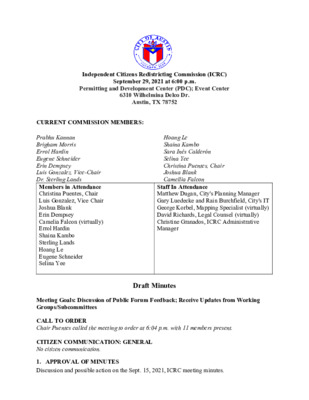
Independent Citizens Redistricting Commission (ICRC) September 29, 2021 at 6:00 p.m. Permitting and Development Center (PDC); Event Center 6310 Wilhelmina Delco Dr. Austin, TX 78752 CURRENT COMMISSION MEMBERS: Prabhu Kannan Brigham Morris Errol Hardin Eugene Schneider Erin Dempsey Luis Gonzalez, Vice-Chair Dr. Sterling Lands Members in Attendance Christina Puentes, Chair Luis Gonzalez, Vice Chair Joshua Blank Erin Dempsey Camelia Falcon (virtually) Errol Hardin Shaina Kambo Sterling Lands Hoang Le Eugene Schneider Selina Yee Hoang Le Shaina Kambo Sara Inés Calderón Selina Yee Christina Puentes, Chair Joshua Blank Camellia Falcon Staff In Attendance Matthew Dugan, City's Planning Manager Gary Luedecke and Rain Burchfield, City's IT George Korbel, Mapping Specialist (virtually) David Richards, Legal Counsel (virtually) Christine Granados, ICRC Administrative Manager Draft Minutes Meeting Goals: Discussion of Public Forum Feedback; Receive Updates from Working Groups/Subcommittees CALL TO ORDER Chair Puentes called the meeting to order at 6:04 p.m. with 11 members present. CITIZEN COMMUNICATION: GENERAL No citizen communication. 1. APPROVAL OF MINUTES Discussion and possible action on the Sept. 15, 2021, ICRC meeting minutes. The Sept. 15, 2021, meeting minutes were approved without objection. 2. POSSIBLE EXECUTIVE SESSION WITH LEGAL COUNSEL – Texas Government Code Annotated §551.071 The ICRC commission adjourned to an Executive Session to consult with Legal Counsel in accordance with Texas Government Code Annotated §551.071. The Executive Session was held. No formal action was taken. 3. NEW BUSINESS The ICRC may discuss and take action on the following agenda items A. Discussion on public forum feedback On Commissioner Hardin's motion, Commissioner Blank's second, the ICRC unanimously approved allowing a number of commissioners, less than a quorum, to synthesize the information from the Sept. 29 meeting and all future public input to draft proposed motions for the Oct. 6, 2021 meeting. B. Updates from working groups/subcommittees On Vice Chair Gonzalez's motion, Commissioner Schneider's second, the ICRC unanimously approved the final round of public forums on Saturday, Oct. 16, 11 a.m.-1 p.m. at South Austin Recreation Center; Monday, Oct. 18, 6-8 p.m. via Zoom and Wednesday, Oct. 20, 6-8 p.m. at the Dell Jewish Community Center. 1. Social Media/Press Release Working Group No update. No update. 2. Advertising/Website Working Group 3. Public Forum Working Group Update 4. Finance Subcommittee No update. 5. Final Report Subcommittee Commissioner Blank gave an update. C. Housekeeping FUTURE AGENDA ITEMS Address map change suggestions Updates from working groups/subcommittees Housekeeping items ADJOURNMENT Chair Puentes …